Life Without Cars
December 21, 2008
Life used to be without cars. Before 1925 or so, only the wealthy had automobiles, and before 1900 nobody did. Most of the cities and civilizations of the world were developed without cars. Indeed, I would argue that there really hasn’t been much in the way of cities and civilizations built since cars became common. Try to name the top ten achievements of European culture after 1950. Name the top ten built environments created after 1950.
However, it is hard today for many to imagine a world without cars. This is because we’ve created an environment in which cars are something close to a necessity. You might as well ask people 40 feet underwater if they can imagine a world without SCUBA gear. So, what we really need to imagine here is not trying to live in a car-dependent wasteland without a car, but rather an environment in which a car is unnecessary and even a useless pain in the butt. Just try to climb Mt. Rainier with your SCUBA gear on. When you are halfway up Mt. Rainier, it becomes very easy to imagine life without SCUBA.
The funny thing is, Life Without Cars (I’ve done it) is actually a lot of fun. There is no hardship or privation involved. It’s cheaper, too, which means everyone can play. Probably the closest many Americans have come to a Life Without Cars is the time they may have spent at a residential university. The university campus is about the best example of a no-car-needed environment you’ll find in the U.S. these days. And wasn’t it fun? Yes, you can have a car for the occasional weekend trip, but on the other hand, you might spend all your time on campus and not want even for that.
There is talk now about finally building out some rail lines in the U.S. I was talking with a friend of mine who is not really a railroad fan. “But, the costs aren’t justified!” he said. Hey, this is government work in the year 2008. You better believe the costs won’t be justified. They will be padded on the order of hundreds of percent. The U.S. government today is mostly a money-laundering operation. When you’re engaging in huge “stimulus” spending, the goal is not whether the benefits justify the costs. The goal is to be left with anything worthwhile at all, once the smoke clears from setting all that money afire. I saw the Japanese government spend enormous amounts on all kinds of stuff. The most worthwhile projects were the train projects. The majority of the spending created nothing of value.
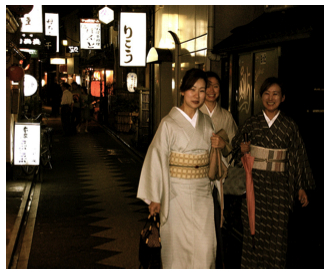
Look at the pretty girls!
OK, now look at the environment they are in. This is in Kyoto. It is not indoors, it is outdoors. Howdya like that street? Is it Really Narrow or what?
Now look at the lights. These are signs for little stores — mostly bars, clubs and restaurants. We can see probably a dozen signs in this picture.
Mmmmm….girls….booze….
Now look at the girls again, especially the fabulous clothes they are wearing. Fits right in, doesn’t it? You can’t wear this sort of thing in an automobile-dominated environment. Maybe a short taxi ride, but you aren’t going to go shopping at the Big Box Mart in such glorious fashion.
Would you believe that, before 1910 or so, everyone dressed like this? In Europe or elsewhere in Asia as well, everyone (who wasn’t dirt poor) had stunning clothes. Men too. It’s not like the Japanese were total nutjobs or something. This was normal.

Would you believe people wore this stuff every day? Rich people, admittedly. But, even so. (Tissot, 1875)

Tissot, 1877. Just a Saturday laying around the house.
Look at how the home is furnished. Wow! There is an aesthetic sophistication here that we come nowhere close to today. Yes, I know this is “old fashioned” and that we are all supposed to lust for the All White New York Apartment, or whatever they are pitching in the Pottery Barn catalog this Christmas. It is very clear to me that people a hundred years ago accomplished vastly more than people today. This is because, I argue, they lived in a built environment which had not yet been destroyed by cars.

A pretty girl. (Whistler, 1882)
Even when people are relatively poor, they dress well, if they are not in an automobile environment.

Traditional Vietnamese women’s wear. All custom tailored. Yes, regular women really do dress like this every day. Or, they used to, when they didn’t have cars (in the mid-1990s when I was last there.) I think they’re wearing mostly western clothes these days. Too bad.

Balinese women in traditional wear.

I don’t know why I stuck this in here, except that it doesn’t have a car. Chinese junk in Halong Bay, Vietnam. Seems like there could be some sort of interesting no-car lifestyle attached.
So, you might be wondering — what’s with the girls? I figure city-building tends to be men’s work. How about if we build an environment in which women can wear this sort of thing and not feel like a freak? That might be fun. (Besides, all advertisers know that if you want to sell something, you have to stick a pretty girl in the picture. Seeing as I’m mostly selling alternative street width, I figure I better sprinkle some chicks in there.)
That’s today’s message.
Life Without Cars Is Fun.
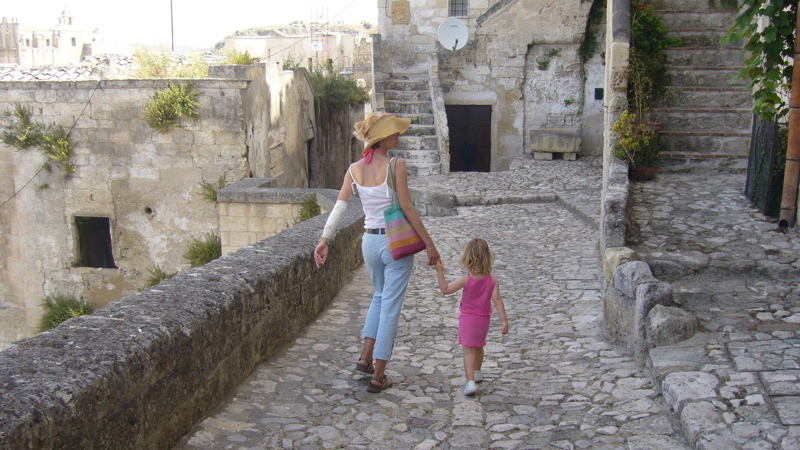
Matera, a small town in Italy. If the town you lived in looked like this, you wouldn’t have to get on a plane and go to Italy.
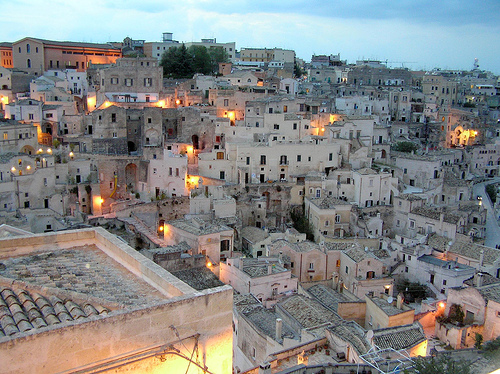
Matera again.
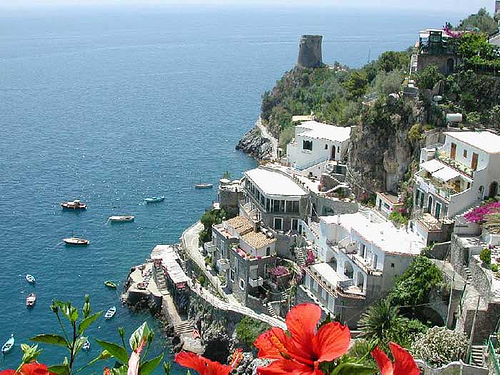
Amalfi Coast, Italy.
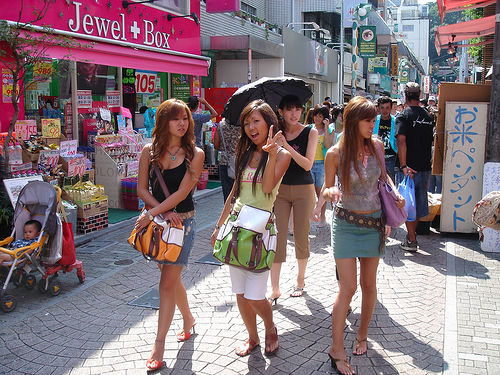
Harajuku, Tokyo.
Look at the girls….
OK, this is more of a contemporary theme. We don’t have to get in a time machine and imitate the habits of 100 years ago. However, despite the aesthetic differences, this is still Life Without Cars. We can appreciate the accomplishments of those prior generations, and use them to help make something even better. Look at the street. This is outdoors, not indoors. Note that it is Really Narrow. Look at all the fun stuff all over the place. It’s a big playground.
The “contemporary” versions of Life Without Cars are not nearly as aesthetically sophisticated as the traditional versions. But, they are still pretty good, and have their own charms.
See also that we are not in a Hypertrophic City, with supergigantic buildings linked with superhighways. No helicopter perspective here.
July 20, 2008: The Traditional City vs. the “Radiant City”
August 10, 2008: Visions of Future Cities
Life Without Cars can be more interesting at every level. Once you get the cars out of the picture, architecture tends to be a lot more interesting.
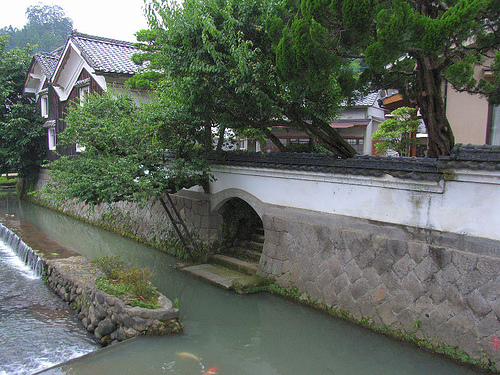


Life Without Cars circa 1787

Paris, possibly 1880s.
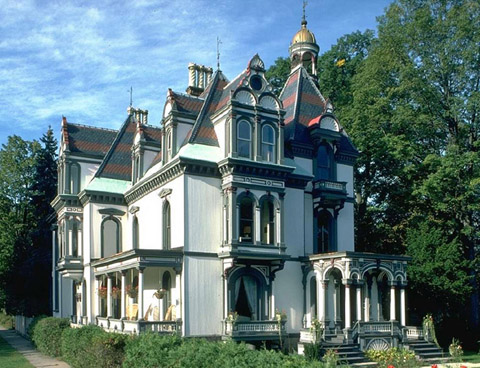
The way people lived. Nineteenth-century house in Saratoga Springs, NY.
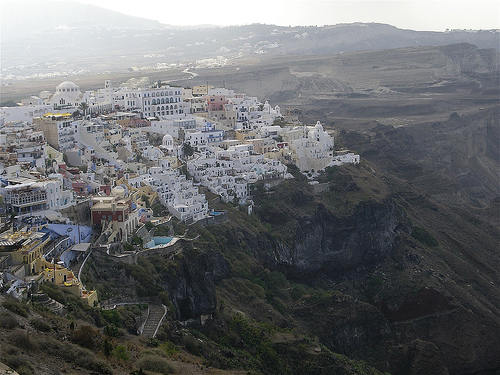
Santorini, Greece

Santorini, closer up. Not a place you’d want to drive. Trust me.

Old Shanghai

Japanese village
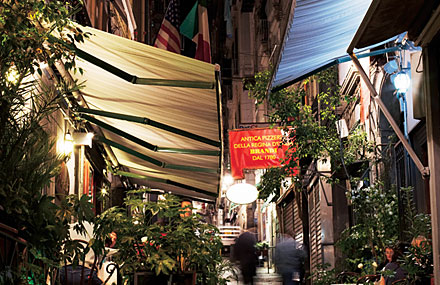
Retaurants in Napoli, Italy. Note the Really Narrowness of the street.
As for the how-to, it’s easy. Sometimes you need to get from Point A to Point B. You either walk or take the train. Problem solved.
I hope you got a flavor of what it is like to be in an environment in which a car is not necessary, and is in fact an irrelevant encumbrance. Humans have about 5000 years of experience in building environments like these, so it shouldn’t be too difficult.
People are starting to sense that the mcmansion/big box/superhighway fantasy is coming to an end. It was a failed experiment. We will have a chance to do something new. Some people will get rich building no-car environments that people want to live in.
Please don’t build a lot of dogshit. We already did that once. It is really not necessary.
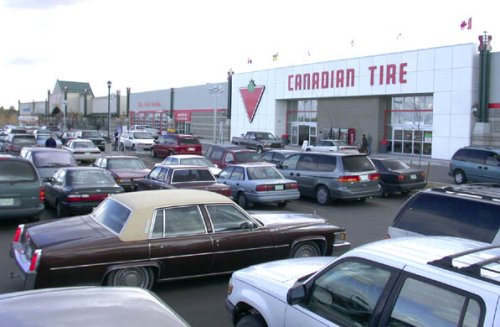
Smells like dogshit, looks like dogshit, feels like dogshit, sounds like dogshit, tastes like dogshit …
Other posts in this series:
August 10, 2008: Visions of Future Cities
July 20, 2008: The Traditional City vs. the “Radiant City”
December 2, 2007: Let’s Take a Trip to Tokyo
October 7, 2007: Let’s Take a Trip to Venice
June 17, 2007: Recipe for Florence
July 9, 2007: No Growth Economics
March 26, 2006: The Eco-Metropolis
* * *
I’ve kinda got that Wow feeling looking at the Fed’s latest FOMC statement. They’re going to print money hither and thither — it says so right there, if I am not mistaken. (Later reports have confirmed this.) Apparently, the Fed has already started to buy agency debt/MBS as promised, using printing-press money. Word from the bond desks is that the big buyer of the long bond is the Fed. So, we don’t have to hypothesize anymore, they’re doing it. A certain amount of this “liquidity” is going into the large holdings of Fed reserves held by banks. This was also true in Japan in the 1990s, and the U.S. in the 1930s. The end story is: what happens to the value of the currency? That is a story about demand as much as supply. Personally, I think the demanders are going to start to realize (finally) that currency quality simply isn’t a priority at this point. We will just have to see how far down the dollar goes. If you don’t have your gold yet, buy it now. You can have your investments, your speculations, and your ready cash. But, you also need something that will make it to the other side of a currency event. Gold, certain forms of property, certain types of small businesses, and practical goods are the go-to items there.
The Federal Open Market Committee decided today to establish a target range for the federal funds rate of 0 to 1/4 percent.
Since the Committee’s last meeting, labor market conditions have deteriorated, and the available data indicate that consumer spending, business investment, and industrial production have declined. Financial markets remain quite strained and credit conditions tight. Overall, the outlook for economic activity has weakened further.Meanwhile, inflationary pressures have diminished appreciably. In light of the declines in the prices of energy and other commodities and the weaker prospects for economic activity, the Committee expects inflation to moderate further in coming quarters.
The Federal Reserve will employ all available tools to promote the resumption of sustainable economic growth and to preserve price stability. In particular, the Committee anticipates that weak economic conditions are likely to warrant exceptionally low levels of the federal funds rate for some time.
The focus of the Committee’s policy going forward will be to support the functioning of financial markets and stimulate the economy through open market operations and other measures that sustain the size of the Federal Reserve’s balance sheet at a high level. As previously announced, over the next few quarters the Federal Reserve will purchase large quantities of agency debt and mortgage-backed securities to provide support to the mortgage and housing markets, and it stands ready to expand its purchases of agency debt and mortgage-backed securities as conditions warrant. The Committee is also evaluating the potential benefits of purchasing longer-term Treasury securities. Early next year, the Federal Reserve will also implement the Term Asset-Backed Securities Loan Facility to facilitate the extension of credit to households and small businesses. The Federal Reserve will continue to consider ways of using its balance sheet to further support credit markets and economic activity.
What to do with the Mainstream Media: If you ignore it, it goes away! Tribune Co., operators of the Chicago Tribune and Los Angeles Times, filed for bankruptcy. Despite rumors, Sam Zell did not buy or own the newspaper. He oversaw a complicated financing (I think the newspaper’s own pension fund was the main owner), in which he got a stake for almost free, and apparently some management oversight as well.
The newspapers have a number of issues, but the foremost is that they are corrupt. And, I say this as a former member of the mainstream media. (It really breaks the spell once you understand how a newspaper is made.) All you have to do is witness the endless parade of Judith Miller’s “an unnamed Pentagon souce said Saddam Hussein is gonna getcha with Weapons of Mass Destruction” articles day after day, when most anyone who knew anything about the subject at all — like former weapons inspector Scott Ritter — was telling you that the “unnamed Pentagon source” (most likely Paul Wolfowitz) was delivering something like pure propoganda. Heck, even I knew there was no WMD in Iraq, before the U.S. invasion, and I am most certainly not a weapons expert. Before that, it was the stony silence (still ongoing) about the real perpetrators of the 9-11 attacks (hint: it wasn’t a bunch of muslim terrorists with a couple hours’ of flight practice), a story the internet intelligentsia demolished a thousand times over. Even the owner of the building, Larry Silverstein, pretty much admitted on television that it was a controlled demolition, and controlled essentially by him. Still — not a peep. Vote fraud in the 2004 presidential elections? More silence from the MSM, while Seattle grandmother Bev Harris was doing the work of a whole building full of “investigative journalists” over at blackboxvoting.org. And what about those chemtrails? When I worked in Manhattan, I would see them probably four days a week overhead. Nary a mention in the New York Times, though. The funny thing is, while I could rattle off a dozen more such examples, the MSM journalist types who whine on endlessly about “integrity of journalism” and so forth probably have no idea what I’m talking about. The majority are useful idiots. A few might have a clue or two, although, typically, not so many as to be inconvenient. Like I said — most hacks are True Believers. A few others understand that they are paid liars, and are happy with that arrangement.
Occasionally, there is a real reporter reporting on a real story. Gary Webb, of the San Jose Mercury News, wrote a blockbuster “Dark Alliance” series in 1996, in which he revealed that, according to drug dealing sources, the main source of crack cocaine in his area was the CIA. The newspaper put thousands of pages of documentary evidence online — it was the early days of the Internet — and later took it off. But — we always knew that too, no? Bill Clinton’s Mena airport was a major import point for CIA drugs. And what did Webb get for this breakthrough journalism? Two shots to the head, deemed a “suicide” of course. Then there was Hunter S. Thompson, sort of a real journalist, who also died of a gunshot wound to the head. The funny thing was, he was on the phone with his wife at the time. His wife said they were having a normal conversation:
Paul William Roberts in his Globe and Mail article of Saturday, February 26, 2005 wrote the following:
Hunter telephoned me on Feb. 19, the night before his death. He sounded scared. It wasn’t always easy to understand what he said, particularly over the phone, he mumbled, yet when there was something he really wanted you to understand, you did. He’d been working on a story about the World Trade Center attacks and had stumbled across what he felt was hard evidence showing the towers had been brought down not by the airplanes that flew into them but by explosive charges set off in their foundations. Now he thought someone was out to stop him publishing it: “They’re gonna make it look like suicide,” he said. “I know how these bastards think . . .”
Now check out this February 25 Associated Press story about Thompson’s death. Sounds a lot like a professional hit with a silencer:
“I was on the phone with him, he set the receiver down and he did it. I heard the clicking of the gun,” Anita Thompson told the Aspen Daily News in Friday’s editions.
She said her husband had asked her to come home from a health club so they could work on his weekly ESPN column…
Thompson said she heard a loud, muffled noise, but didn’t know what had happened. “I was waiting for him to get back on the phone,” she said. (Her account to Rocky Mountain News reporter Jeff Kass is slightly different: “I did not hear any bang,” she told Kass. She added that Thompson’s son, who was in the house at the time, believed that a book had fallen when he heard the shot, according to Kass’ report.)
Mack White sums up the questions well:
Thompson’s family says he was not depressed, nor was he in enough to pain to kill himself. In fact, by all reports, he was quite happy. He was talking on the phone to his wife, getting ready to work on his column, when he decided it would be wise to kill himself, so that he could go out (we are told) while “still at the top of his form,” even though this would mean not finishing his column or his expose on 9/11 (potentially the most important thing he would ever write) (?)…
http://www.infowars.com/articles/ps/hunter_s_thompson_suicided_for_911_story.htm
That’s what happens to real journalists. Goodbye, mainstream media, and good riddance!
The Best Newspaper in the English Language award goes to WhatReallyHappened.com, run by one single guy in his free time. It’s amazing what is possible when you don’t have to bow and scrape to advertisers and shareholders, and other Powers That Be.
* * *
By the way, I put on the thermal paint in our bathroom and laundry areas. The reflective microspheres are like a very fine sand, so fine it is almost like a liquid. (Since they are mostly silicon, doped with a little boron, “a very fine sand” is almost exactly correct.) Mixed with paint, it creates something like a very fine stucco. The surface has a bit of granular texture, like 600 grit sandpaper. As recommended, two coats are needed for full coverage. Is there a difference? It seems toastier there now, to me. I’m satisfied. Certainly, if one was going to paint the walls anyway, I would definitely go this route. It’s about as close to something for nothing as you’ll find.

